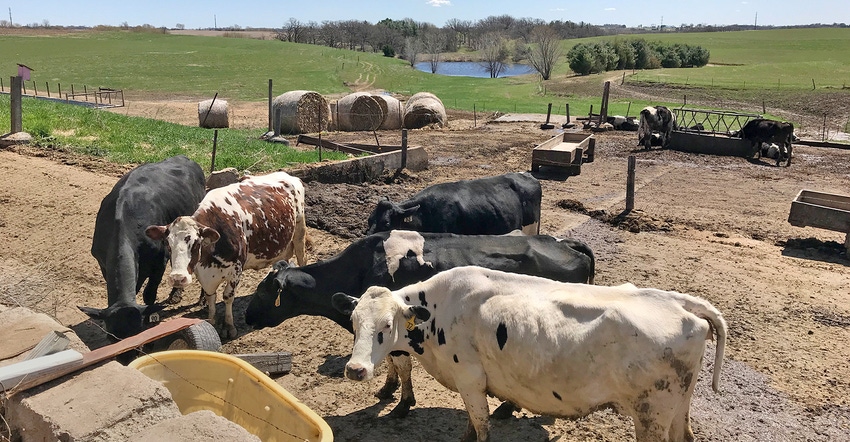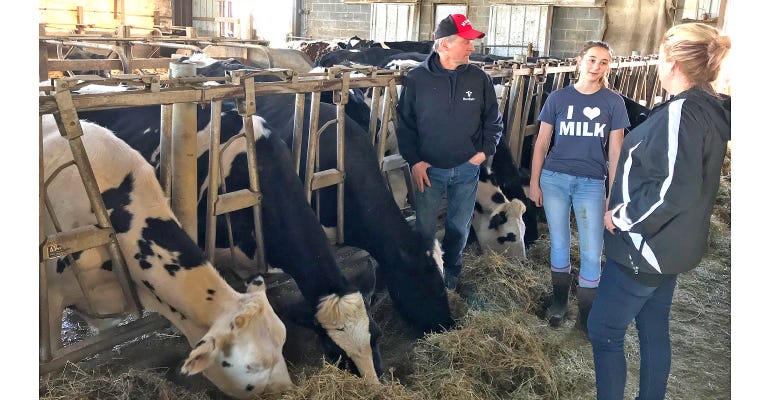June 12, 2019

With alfalfa in the crop rotation and pastureland in the mix, Stacy Miller’s 350-acre Plainview dairy farm that he runs with his wife, Julie, already played a role in filtering runoff flowing toward the Mississippi River.
With a new lagoon and nutrient management plan, the 85-cow operation now does even more to protect groundwater and trout streams.
The 700,000-gallon, $440,000 manure storage facility is the second one constructed with assistance from the Lower Mississippi River Feedlot Management in Minnesota Regional Conservation Partnership Project.
Funded jointly by the Minnesota Board of Water and Soil Resources and the USDA’s Natural Resources Conservation Service, the $3.2 million, five-year RCPP feedlot management project provides a 90% cost-share to producers who build facilities that mitigate feedlot runoff. The project targets livestock operations with fewer than 300 or fewer than 500 animal units — the limit depends upon the state funding source — in 11 southeastern Minnesota counties.
“The whole purpose is trying to protect the surface water and groundwater in the karst landscape,” says Dave Copeland, the BWSR board conservationist assigned to the project. “It’s a landscape that really needs livestock. It needs farmers out there who are going to have a diverse crop rotation, including that perennial hay rotation and including well-managed pastures. Along with that opportunity comes a need to manage the manure.”
Regional water quality data and modeling previously identified livestock operations as major contributors of nutrients, bacteria and sediment to Mississippi River tributaries. The biggest resource concern on the Millers’ Wabasha County farm: With no storage, it was necessary to spread manure every day. Spreading on frozen ground increases the chances of runoff.
“Now, instead of having to spread every day, a person can spread when the conditions are a little more favorable,” Stacy says.
The lagoon will provide about 12 months’ storage.

WATER QUALITY PARTNERS: Stacy Miller (left) and his daughter Melendy talked to Terri Peters, Wabasha Soil and Water Conservation district manager, about the manure storage lagoon built with assistance from the Lower Mississippi River Feedlot Management in Minnesota Regional Conservation Partnership Project. The project is funded jointly by the Minnesota Board of Water and Soil Resources and USDA’s Natural Resources Conservation Service. Landowners provide a match.

Wabasha SWCD staff first worked with Miller in the early 1980s when he installed ponds, waterways and contour strips. He switched from a stanchion barn to a parlor barn in the 1990s when his children were young. For the past few years, he considered a feedlot upgrade.
“I had wished I had something other than scrape-and-haul for a long time, but the expense of it didn’t work into my plan very well,” Stacy says. “I couldn’t see spending that much on a manure storage facility because it was more than twice the price of the farm when I paid for the farm. When they had the 90% cost-share, it became really attractive.”
The Millers’ farm is at the top of the watershed that drains into East Indian Creek, a trout stream that flows east to the Mississippi River. Wabasha County alone contains 117 miles of designated trout streams — 18 streams entirely within its borders, plus segments of two more.
With fields in three separate sites, Stacy had been hauling manure three miles on a busy state highway.
“Anybody who does that knows that is no fun at all because there’s always traffic to deal with and it creates all kinds of issues,” he says.
The new lagoon not only ended daily hauling but also cut time spent on chores by about two hours a day. Miller’s nutrient management plan calls for fall field application via injection.
“If somebody takes over the dairy farm, they’re going to have things a lot nicer than I did,” Stacy says.
Prospects include Stacy and Julie’s three children.
Melendy, 21, a dairy science major at the University of Wisconsin-River Falls, will spend next semester living and working on the farm before she graduates in December.
“The only way to figure out if this is what you want is to do it 100%,” she says.
Mika, 19, is also studying dairy science at UWRF. Her twin, Marcus, worked on the farm until recently, when he got a job with a Rochester landscaper.
Stacy, 59, grew up on a dairy farm four miles down the road and went to school for carpentry before returning to work with his father and two brothers. He bought the Wabasha County farm in 1982 and started milking cows in 1983.
Construction on the lagoon started in May 2018 and ran through mid-November. Three heavy rains delayed work and added to the expense. The concrete pit is surrounded by an earthen berm. An emergency spillway opens onto a 30,000-square-foot meadow. Fencing a cattle lane from the barn to pasture was planned for this spring.
Follow-up includes continued manure and soil testing.
The five-year Lower Mississippi River Feedlot Management in Minnesota RCPP runs through 2020. BWSR’s $1.6 million contribution includes a $300,000 Clean Water Fund grant. NRCS is providing Environmental Quality Incentives Program implementation funds.
Copeland says remaining project funds could build four or five more manure storage facilities. For the size of operations being targeted, the average cost is $400,000. More than a dozen applications are in the works.
Besides the two lagoons, funding to date has allowed about 10 producers to develop comprehensive nutrient management plans.
Producers still can apply for funding through the Lower Mississippi River Feedlot Management in Minnesota RCPP. NRCS has not announced the sign-up deadline for 2020. The RCPP provides a higher level of financial assistance. But other sources are available, and the Wabasha SWCD accepts continuous sign-ups for manure management practices.
“A healthy livestock economy is important to protecting the resources here in southeast Minnesota,” Copeland says. “Whatever can be done to keep a healthy livestock economy and keep those livestock producers on their farms, it’s important for us to do that — to try to provide what they need, because if we can keep hay in rotation in the landscape, we’re going to go a long way to try to address the water quality issues in southeastern Minnesota.”
Source: BWSR, which is solely responsible for the information provided and is wholly owned by the source. Informa Business Media and all its subsidiaries are not responsible for any of the content contained in this information asset.
You May Also Like




